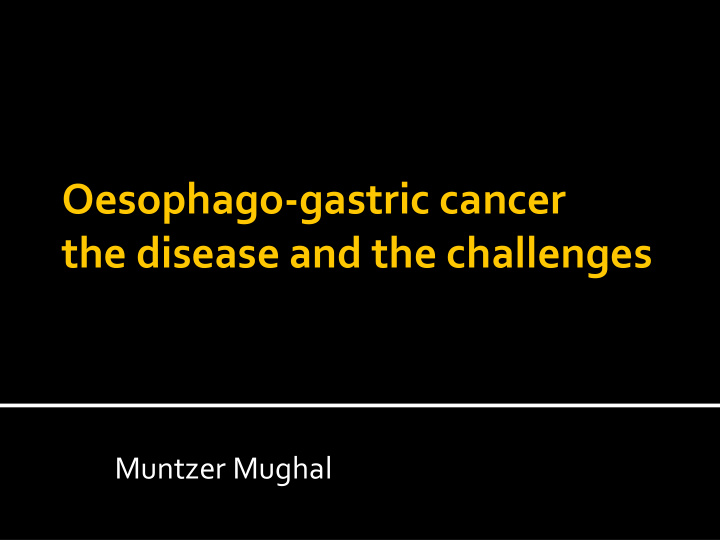



Oesophago ‐ gastric cancer the disease and the challenges Muntzer Mughal
Oesophago ‐ gastric cancer How common is it? What causes it? What are the symptoms? How is it treated? Recent advances in: Detection Treatment The future
Eastern Asia Eastern Europe Polynesia South America World Southern Europe Central America Caribbean Middle Africa Western Europe Northern Europe Western Asia Australia/New South-Eastern Asia Southern Africa Northern America Eastern Africa Males South Central Asia Melanesia Females Micronesia Northern Africa Western Africa 0 10 20 30 40 50 Rate per 100,000 population
China Southern Africa Eastern Africa Japan South Central Asia Northern Europe Western Europe South America Caribbean Melanesia Eastern Europe Northern America Australia/New Zealand Males Southern Europe South-Eastern Asia Females Western Asia Micro/Polynesia Central America Northern Africa Middle Africa Western Africa 0 5 10 15 20 25 30 Rate per 100,000 population
Stomach 7th commonest cancer 8200 new cases a year 6000 deaths a year Oesophagus 9th commonest cancer 7640 new cases a year 7400 deaths a year
Oesophagus Stomach 20 18 16 per 1 0 0 ,0 0 0 population 14 12 10 8 6 4 2 0 Scotland Northern North West Trent Anglia Wales N Thames S Thames N Ireland
9 th commonest cancer in the U.K Commonly diagnosed at a late stage UK 20% presenting as emergency Japan 50% diagnosed early 5-year survival Japan 41% Europe 10% UK 9%
Lifestyle Alcohol Smoking Diet Salty/pickled food Obesity Barrett’s oesophagus
Diet salty/pickled food Lifestyle Alcohol Smoking Infection Helicobacter pylori
Rate per 100,000 population 10 12 14 16 0 2 4 6 8 1975 1978 males 1981 1984 females Year of diagnosis 1987 1990 persons 1993 1996 1999 2002
Rate per 100,000 population 10 15 20 25 0 5 1993 1994 1995 males 1996 1997 Year of diagnosis 1998 females 1999 2000 2001 persons 2002 2003 2004
O ‐ G cancer symptoms Indigestion that won’t go away Difficulty with swallowing Weight loss Jaundice But even the earliest SYMPTOMS often associated with advanced cancer
6,137,325 examinations between 1968 – 1998 6394 cancers detected (0.104%) Disease stage: I 72.5% II 10.3% III 11.2% IV 6%
Primary prevention Public awareness – obesity, alcohol & smoking Early diagnosis Public awareness Easier access to endoscopy Surveillance & screening of high risk groups Barrett’s Better treatment
GP Dysphagia, heartburn Disease free No or subtle symptoms
Acceptability and accuracy of a non-endoscopic screening test for Barrett's oesophagus in primary care: cohort study. Kadri SR et al BMJ. 2010 Sep 10;341:c4372. doi: 10.1136/bmj.c4372
Extent of the disease Scans Inspection of abdominal cavity General level of fitness Tailoring to the individual Palliative if advanced Curative if localised Surgery ± chemotherapy/radiotherapy
Stomach Usually removal of whole stomach with lymph glands Oesophagus Removal of major part of oesophagus & part of stomach
Most patients in 60s and 70s Some have other medical problems Operations are long & complex Oesophagectomy involves opening the abdomen and the chest Therefore, potentially high morbidity and mortality
Gastrectomy 6 weeks off work, 6 ‐ 9 months to get back to ‘normal’ Smaller meals, difficulty regaining weight Oesophagectomy 12 weeks off work, 12 months to get back to normal Smaller meals, difficulty regaining weight
1987 - 1991 1997 - 2000 Mortality after 10% 5% surgery 1-year survival 47% 62% 5-year survival 20% 31%
Better ‘mapping’ (staging) of the disease Better tailoring of treatment Multidisciplinary Team approach Better surgery & after ‐ care Endoscopic treatment of early disease Key ‐ hole surgery! Specialisation & centralisation
O ‐ G Cancer MDT at UCLH World ‐ class UGI gastroenterology service Endoscopic treatment of early tumours Interventional techniques – laser, stenting Research Excellent oncology services Strong surgical service 387 cases discussed and 82 resections since Feb 2011 with 1 death Expertise for complex and re ‐ operative surgery
Covering population of 3.5 M Appointment of O ‐ G Pathway Board Directors David Khoo (Queens Hospital in Romford) Muntzer Mughal Programme to improve outcomes: Earlier diagnosis Smoother pathway through staging to treatment Fewer centres for surgery More enrolment of patients into trials
Regional surgical centre 1.5 million population base >600 cancers a year >100 operations a year 6 experienced surgeons
10 miles
Preventative strategies Public awareness New tests for earlier detection Better tests to show signs of spread Safer and more effective chemotherapy Safer and more effective surgery Smaller proportion of patients will have surgery, but outcomes will be better
Recommend
More recommend